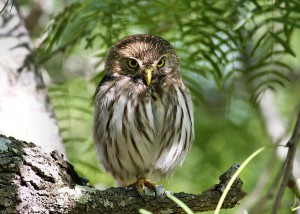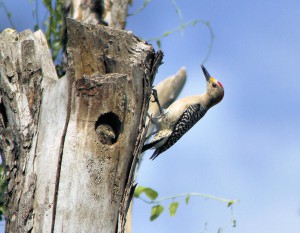Two of us visited the gulf coast to search for Texas owls. At this time of year we also went to see some of the North American bird migration. Trying out a few of the new products we are starting to offer at Optics4Birding was a great excuse for our trip. We flew in on April 20th and returned home to southern California on April 28th. In this entry to the blog I will be talking mainly about the Texas owls we saw. More details, calls, and photos can be found on our sister web site Owling.com.
During the last 4 days of our trip, we were in the lower Rio Grande Valley. It was there that we found the three Texas owls species featured in this post. I shot all of the photos in this post with the Canon 7D digital camera. Optics4Birding now carries Canon cameras, lenses and accessories. I have been shooting with Canon equipment for many years now. Yet I got a new 7D virtually the day before this trip. I can’t say enough good things about this camera. It was very impressive. We saw lots of birders carrying them while we were out in the field.
Elf Owl – The First of the Texas Owls
The first of the Texas owls that we came upon was in Bentsen Rio Grande Valley State Park. We happened to be watching a Golden-fronted Woodpecker. I thought the woodpecker might be nesting in this tree when he stuck his head in a hole that was near the top. I guess not! The woodpecker quickly jumped off to the right and out popped another little bird’s face to see who the intruder was. I wasn’t quite ready to take pictures of this event but I had the Canon 7D equipped with a 70-300mm IS lens. The lens is small, light and easy to carry in the field. This lens is great for birders who want a simple lens to catch moments just like this.
The woodpecker and the owl
As the bird emerged from the hole, I realized it was an Elf Owl with its little round face. This is debatably the smallest owl in the world (one South American species may be slightly lighter). With that big powerful bill we had to wonder why this woodpecker was being so cautious. The Elf Owl is only about half his size. We asked the ranger about this. He said that the woodpeckers had been hanging around the hole that the owl resided in. I think that the owl stole this hole from them and they weren’t happy about it. Although Elf Owls are strictly insectivorous, the woodpeckers are being cautious that the owl does not bite them.
Elf Owl size and Habits
The Elf Owls are one of the most migratory owls in North America and generally only occur as far north as Texas, New Mexico and Arizona, arriving each spring. Elf Owl is a tiny bird, about the same size as a large sparrow. It pleased us to have stumbled across this encounter between the owl and woodpecker. This owl was just too cute as he looked out at us sleepily. We joked about how tired the owl was. It just couldn’t quite keep its eyes all the way open as it peered down at us. The owl quickly retired back down in his hole. It was a treat to witness this interaction. I knew the Elf Owls were possible here although I wasn’t specifically looking one. Obviously birds respect all owls, regardless of their size!
Eastern Screech-Owl
The next of our Texas owls was an Eastern Screech Owl. We chanced upon this one only a few hundred yards from the Elf Owl. This is the eastern cousin of our Western Screech Owl from home, and the two species are extremely similar in appearance (debatably indistinguishable by appearance alone). The Eastern Screech-Owl, like the Elf Owl, is strictly nocturnal and was visibly very sleepy. This picture is also a great example of the potential photo quality using the 70-300mm Canon lens. This owl has very good camouflaged plumage. Standing at the entrance to its hole, when it closed its eyes it was almost invisible against the tree trunk.
Suddenly, the owl opened its eyes and flew to a nearby tree. It didn’t seem too bothered by me taking photos but something it heard woke him right up and it was very alert. Although I have taken many pictures of Western and Whiskered Screech-Owls, Eastern Screech-Owl is the only screech-owl species in all of North and Central America that I had not previously photographed. In fact, Eastern Screech-Owl was the last North American owl species I needed to photograph. That made this bird a very special one for me, and it also saved me from further night owling adventures with the Texas mosquitoes (I had missed finding Eastern Screech-Owl in the Houston area).
Ferruginous Pygmy Owl
The last owl we planned to see in Texas was the Ferruginous Pygmy Owl. It is the rarest owl in North America, found only in Arizona and Texas. I have seen this owl a few times in Arizona. Though very small (as the name implies) Ferruginous Pygmy-Owls are incredibly ferocious. They feed mostly on small birds, but will attack birds up to twice their size. For this bird, I used the 400mm non image stabilized Canon lens. I think the pictures speak for themselves in quality although I am used to using and prefer a zoom lens. The 100-400mm IS Canon lens is also very popular amongst birders and what I normally use for taking photos while bird watching but this is a discussion for another time.
Behavior

This Ferruginous Pygmy-Owl in Texas was calmly sitting on a tree branch. It kept a sharp eye open for potential prey.
It is hard to appreciate how small the Ferruginous Pygmy-Owl really is: though larger than the Elf Owl, it is still only half the size of a Mourning Dove. I once saw a Ferruginous Pygmy-Owl take a bite out of a dove in Mexico while it was making a dive-bombing run at the owl. Other birds may mob and make a fuss about a pygmy-owl in their area, but if one of the attackers gets a little too close it becomes lunch for the owl. The identifying markings of this owl are the streaking on the crown and the rust color on the tail. Northern and Mountain Pygmy-Owls both have round white spots rather than streaks on the crown and white tail bars. Both those species are usually found at a higher elevation.
Texas verses Arizona

The white forehead streaking of the Ferruginous Pygmy-Owl separate it from the similiar Northern or Mountain Pygmy-Owls.
Ferruginous Pygmy-Owl is getting easier to see in Texas because it is found on well-known ranches where, for a small fee, the ranchers will take you out to see them. These photos were taken at San Miguelito Ranch where there was a breeding pair. The owners couldn’t have been nicer and we got very close looks at the owls. I assume there are similar numbers of these owls in Texas as there are in Arizona. A few years ago while helping the Arizona Fish and Game one of the guys told me they figured there were about 17 pair in the entire state. Finding any on your own could be quite difficult, so going into a known ranch is probably a good plan to see this owl.






